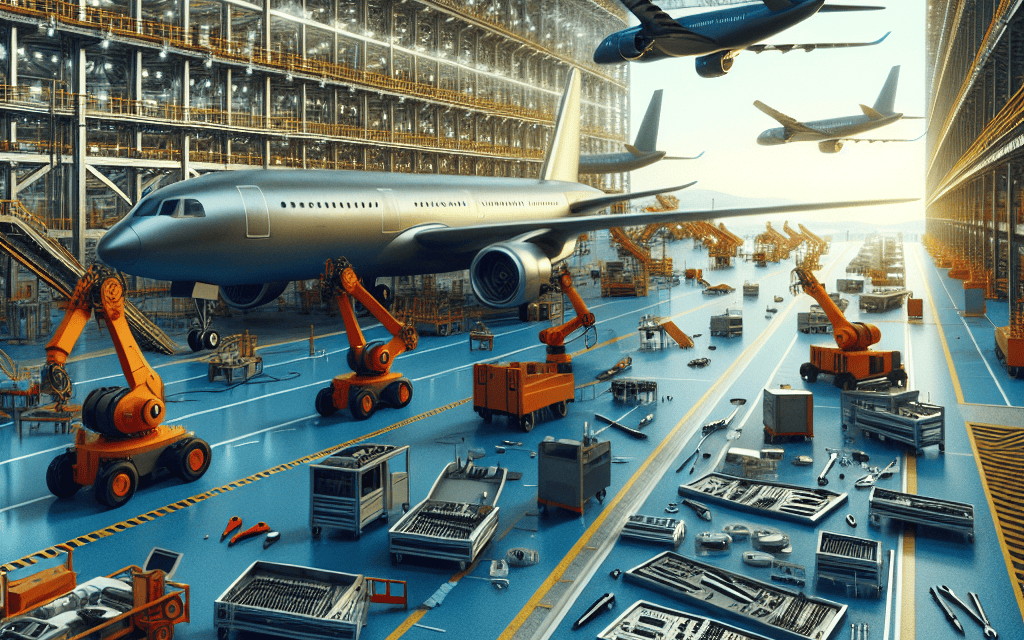“Skyward Dreams Grounded: Major Layoffs Hit Aerospace Giants Boeing and Airbus”
Introduction
The aerospace industry is grappling with significant challenges as major players like Boeing and Airbus announce substantial workforce reductions. These layoffs come amid a turbulent period marked by fluctuating demand, supply chain disruptions, and evolving market dynamics. As the industry navigates these complexities, the decision to downsize reflects broader strategic adjustments aimed at maintaining financial stability and operational efficiency. The impact of these layoffs extends beyond the companies themselves, affecting thousands of employees and the communities that rely on the aerospace sector for economic vitality. This development underscores the urgent need for adaptation and resilience in an industry that is pivotal to global transportation and technological advancement.
Impact Of Major Layoffs On The Aerospace Industry
The aerospace industry, a cornerstone of global transportation and defense, is currently grappling with significant challenges as major players like Boeing and Airbus announce substantial workforce reductions. These layoffs, driven by a confluence of factors, are poised to have far-reaching implications not only for the companies themselves but also for the broader industry and its supply chain. As the world continues to recover from the economic disruptions caused by the COVID-19 pandemic, the aerospace sector is facing a slower-than-expected rebound in demand for commercial aircraft. This sluggish recovery has compelled industry giants to reassess their operational strategies, leading to difficult decisions regarding workforce management.
Boeing and Airbus, two of the largest aircraft manufacturers globally, have been at the forefront of these developments. Both companies have cited a combination of reduced demand for new aircraft, supply chain disruptions, and the need to streamline operations as primary reasons for the layoffs. For Boeing, the situation is further compounded by the lingering effects of the 737 MAX crisis, which has eroded customer confidence and financial stability. Meanwhile, Airbus is navigating its own set of challenges, including geopolitical tensions and fluctuating market conditions, which have necessitated a reevaluation of its workforce needs.
The impact of these layoffs extends beyond the immediate loss of jobs. The aerospace industry is characterized by a complex and interdependent supply chain, with numerous small and medium-sized enterprises (SMEs) providing essential components and services. As Boeing and Airbus reduce their workforce, the ripple effects are likely to be felt throughout this network. Suppliers may face reduced orders, leading to financial strain and potential job losses within their own operations. This interconnectedness underscores the broader economic implications of the layoffs, as communities reliant on aerospace manufacturing may experience economic downturns.
Moreover, the reduction in workforce could hinder innovation within the industry. The aerospace sector is renowned for its cutting-edge research and development, driving advancements in technology and sustainability. However, with fewer employees, companies may find it challenging to maintain the same level of investment in these areas. This could slow the pace of innovation, affecting the industry’s ability to meet future demands for more efficient and environmentally friendly aircraft.
In addition to economic and innovation-related consequences, the layoffs also raise concerns about the retention of skilled talent within the industry. Aerospace engineering and manufacturing require highly specialized skills, and the loss of experienced workers could create a talent gap that is difficult to fill in the future. As the industry eventually recovers and demand for new aircraft increases, companies may face challenges in recruiting and training new employees to meet production needs.
Despite these challenges, there are potential opportunities for the aerospace industry to adapt and evolve. The current situation may prompt companies to explore new business models, such as increased focus on aftermarket services and digital solutions. Additionally, the push for sustainability and decarbonization in aviation could drive investment in alternative fuels and electric aircraft, creating new avenues for growth and employment.
In conclusion, the major layoffs announced by Boeing and Airbus represent a significant turning point for the aerospace industry. While the immediate impact is characterized by job losses and economic uncertainty, the long-term effects will depend on how the industry navigates these challenges and seizes opportunities for transformation. As the world continues to change, the aerospace sector must adapt to ensure its resilience and continued contribution to global connectivity and innovation.
Boeing And Airbus Workforce Reductions: Causes And Consequences
The aerospace industry, a cornerstone of global transportation and defense, is currently experiencing significant turbulence as major players like Boeing and Airbus announce substantial workforce reductions. These layoffs, affecting thousands of employees worldwide, are a direct consequence of several interrelated factors that have converged to create a challenging environment for the industry. Understanding the causes behind these workforce reductions and their potential consequences is crucial for stakeholders and observers alike.
To begin with, the COVID-19 pandemic has had a profound impact on the aerospace sector. The pandemic led to a dramatic decline in air travel demand, as countries imposed travel restrictions and passengers opted to stay home. This sudden drop in demand forced airlines to cancel or defer orders for new aircraft, directly affecting manufacturers like Boeing and Airbus. Consequently, both companies have faced reduced revenues and have been compelled to reassess their production rates and workforce needs. The pandemic’s lingering effects continue to cast a shadow over the industry’s recovery, with air travel not expected to return to pre-pandemic levels for several years.
In addition to the pandemic’s impact, Boeing has faced its own set of challenges, particularly with the 737 MAX crisis. The grounding of the 737 MAX fleet following two fatal crashes severely damaged Boeing’s reputation and financial standing. The company has had to navigate a complex process of recertification and rebuilding trust with regulators and customers. This crisis has further strained Boeing’s resources, necessitating cost-cutting measures, including workforce reductions, to stabilize its operations.
Similarly, Airbus has encountered its share of difficulties, albeit of a different nature. The European aerospace giant has been grappling with supply chain disruptions and increased competition from emerging markets. These challenges have pressured Airbus to streamline its operations and focus on efficiency, leading to the difficult decision to reduce its workforce. Moreover, geopolitical tensions and trade disputes have added another layer of complexity, affecting the global aerospace supply chain and market dynamics.
The consequences of these workforce reductions are multifaceted. On an economic level, the layoffs will have a ripple effect, impacting not only the employees directly affected but also the communities and industries that rely on the aerospace sector. The loss of skilled labor could hinder the industry’s ability to innovate and maintain its competitive edge in the long term. Furthermore, the reduction in workforce may slow down production rates, potentially delaying the delivery of new aircraft and affecting airlines’ fleet renewal plans.
On a broader scale, these layoffs highlight the need for the aerospace industry to adapt to a rapidly changing landscape. Companies must invest in new technologies and sustainable practices to meet evolving market demands and environmental regulations. This transition may require a shift in workforce skills, emphasizing the importance of retraining and upskilling programs to prepare employees for future roles within the industry.
In conclusion, the workforce reductions at Boeing and Airbus are a reflection of the significant challenges facing the aerospace industry today. While these layoffs are a necessary response to current economic pressures, they also underscore the need for strategic adaptation and innovation. As the industry navigates this period of uncertainty, collaboration among stakeholders, including governments, companies, and employees, will be essential to ensure a resilient and sustainable future for aerospace.
Strategies For Aerospace Professionals Facing Job Loss
The aerospace industry, a cornerstone of technological advancement and global connectivity, is currently experiencing significant turbulence as major players like Boeing and Airbus announce substantial workforce reductions. This development has sent ripples of concern throughout the sector, leaving many professionals grappling with the uncertainty of job loss. In light of these challenges, it is crucial for affected individuals to adopt strategic approaches to navigate this transitional period effectively.
First and foremost, professionals facing job loss should prioritize updating their resumes and LinkedIn profiles to reflect their most recent experiences and accomplishments. This step is essential in ensuring that they remain competitive in a job market that is likely to become increasingly saturated. By highlighting specific skills and achievements, individuals can better position themselves for opportunities that may arise within or outside the aerospace sector.
In addition to updating professional profiles, networking remains a vital strategy for those seeking new employment. Engaging with industry peers, attending virtual conferences, and participating in relevant online forums can provide valuable insights and connections. These interactions not only open doors to potential job opportunities but also offer a platform for sharing experiences and advice with others in similar situations. Moreover, networking can lead to collaborations on projects or initiatives that may not have been previously considered.
While networking is crucial, it is equally important for aerospace professionals to consider diversifying their skill sets. The current landscape presents an opportune moment to explore additional training or certifications that can enhance employability. For instance, gaining expertise in emerging technologies such as artificial intelligence, data analytics, or sustainable aviation can provide a competitive edge. Many educational institutions and online platforms offer courses tailored to these areas, allowing individuals to upskill at their own pace.
Furthermore, professionals should remain open to exploring opportunities beyond the traditional aerospace industry. The skills and knowledge acquired in aerospace are often transferable to other sectors, such as automotive, defense, or renewable energy. By broadening their job search to include these industries, individuals can increase their chances of finding suitable employment. This flexibility not only expands potential job prospects but also allows for personal and professional growth in new and exciting fields.
In addition to these proactive measures, it is essential for individuals to maintain a positive mindset during this challenging time. Job loss can be a significant emotional burden, and it is important to acknowledge and address these feelings. Seeking support from family, friends, or professional counselors can provide the necessary emotional resilience to navigate this period of uncertainty. Maintaining a balanced routine that includes regular exercise, healthy eating, and adequate rest can also contribute to overall well-being.
Finally, staying informed about industry trends and developments is crucial for aerospace professionals. By keeping abreast of news related to aerospace advancements, government policies, and market demands, individuals can better anticipate potential opportunities and challenges. This knowledge not only aids in making informed career decisions but also demonstrates a continued commitment to the field.
In conclusion, while the current wave of layoffs in the aerospace industry presents significant challenges, it also offers an opportunity for professionals to reassess and realign their career paths. By adopting a strategic approach that includes updating professional profiles, networking, diversifying skills, exploring new industries, maintaining a positive mindset, and staying informed, individuals can navigate this transitional period with resilience and adaptability.
The Future Of The Aerospace Industry Amid Workforce Cuts

The aerospace industry, a cornerstone of global transportation and a significant contributor to technological advancement, is currently navigating turbulent skies as major players like Boeing and Airbus announce substantial workforce reductions. These layoffs, driven by a confluence of factors, are reshaping the landscape of the industry and prompting a reevaluation of its future trajectory. As the world grapples with the aftermath of the COVID-19 pandemic, the aerospace sector is particularly vulnerable due to its reliance on international travel and trade, both of which have been severely disrupted.
The pandemic-induced downturn in air travel has led to a precipitous drop in demand for new aircraft, compelling manufacturers to reassess their production strategies. Boeing and Airbus, the two titans of the industry, have been forced to make difficult decisions to align their operations with the current market realities. Boeing, for instance, has announced plans to cut thousands of jobs, citing the need to streamline operations and reduce costs in response to decreased demand. Similarly, Airbus has unveiled a restructuring plan that includes significant workforce reductions, aiming to preserve its financial health amid ongoing uncertainty.
These workforce cuts, while necessary from a business perspective, have far-reaching implications for the aerospace industry. The loss of skilled labor not only affects the immediate production capabilities of these companies but also poses a long-term challenge in terms of innovation and competitiveness. The aerospace sector has historically been a hub of technological advancement, driving progress in areas such as materials science, aerodynamics, and avionics. However, with fewer engineers and technicians, the pace of innovation may slow, potentially impacting the industry’s ability to meet future demands for more efficient and sustainable aircraft.
Moreover, the ripple effects of these layoffs extend beyond the companies themselves, affecting the broader supply chain and the communities that depend on aerospace jobs. Suppliers, many of which are small to medium-sized enterprises, face reduced orders and financial strain, leading to further job losses and economic hardship. This interconnectedness underscores the importance of strategic planning and support from governments and industry stakeholders to mitigate the adverse effects of workforce reductions.
Despite these challenges, the aerospace industry is not without hope. The current crisis presents an opportunity for transformation and adaptation. Companies are increasingly investing in digital technologies and automation to enhance efficiency and reduce reliance on manual labor. Additionally, there is a growing emphasis on sustainability, with manufacturers exploring alternative fuels and electric propulsion systems to address environmental concerns and meet regulatory requirements.
In this context, workforce development and retraining programs become crucial. By equipping displaced workers with new skills, the industry can ensure a smoother transition and maintain a pool of talent ready to tackle emerging challenges. Collaboration between industry, academia, and government will be essential to create pathways for reskilling and to foster innovation.
In conclusion, while the aerospace industry faces significant hurdles due to workforce cuts by Boeing and Airbus, it also stands at a crossroads with the potential for reinvention. By embracing technological advancements and prioritizing sustainability, the industry can navigate these turbulent times and emerge stronger. The path forward will require concerted efforts from all stakeholders to balance immediate economic pressures with long-term strategic goals, ensuring that the aerospace sector continues to soar in the years to come.
Economic Implications Of Layoffs In The Aerospace Sector
The aerospace industry, a cornerstone of global economic development and technological advancement, is currently facing a significant challenge as major players like Boeing and Airbus announce substantial workforce reductions. These layoffs, driven by a combination of factors including decreased demand, supply chain disruptions, and evolving market dynamics, are poised to have far-reaching economic implications. As the industry grapples with these changes, it is crucial to understand the broader economic context and the potential ripple effects on related sectors and communities.
To begin with, the aerospace sector has long been a major contributor to economic growth, providing high-skilled employment opportunities and fostering innovation. However, the recent downturn in air travel demand, exacerbated by the COVID-19 pandemic and subsequent shifts in consumer behavior, has led to a reevaluation of production needs. Consequently, companies like Boeing and Airbus are compelled to adjust their workforce to align with the new market realities. This decision, while necessary for maintaining financial stability, inevitably results in significant job losses, affecting thousands of employees and their families.
Moreover, the impact of these layoffs extends beyond the immediate loss of employment. The aerospace industry is intricately linked to a vast network of suppliers and service providers, many of which are small to medium-sized enterprises. As major manufacturers scale back production, these suppliers face reduced orders, leading to potential financial strain and further job cuts. This interconnectedness underscores the cascading effect that layoffs in the aerospace sector can have on the broader economy, particularly in regions heavily reliant on aerospace manufacturing.
In addition to the direct economic consequences, the reduction in workforce also poses challenges for innovation and technological advancement within the industry. The aerospace sector is renowned for its cutting-edge research and development, driving progress in areas such as sustainable aviation, advanced materials, and autonomous systems. However, with fewer resources and personnel dedicated to these initiatives, there is a risk of slowing down the pace of innovation. This could have long-term implications for the industry’s competitiveness on the global stage, as emerging markets and new entrants continue to invest heavily in aerospace technologies.
Furthermore, the social implications of these layoffs cannot be overlooked. The loss of high-skilled jobs can lead to increased unemployment rates and economic hardship for affected individuals and communities. This, in turn, may result in decreased consumer spending, further dampening economic recovery efforts. Governments and policymakers are thus faced with the challenge of implementing effective support measures, such as retraining programs and economic stimulus packages, to mitigate the impact on displaced workers and stimulate job creation in other sectors.
In conclusion, the major layoffs announced by Boeing and Airbus signal a pivotal moment for the aerospace industry, with significant economic implications that extend beyond the immediate loss of jobs. As the sector navigates this period of transition, it is essential for stakeholders to collaborate and develop strategies that address both the short-term challenges and the long-term opportunities for growth and innovation. By doing so, the aerospace industry can emerge more resilient and better equipped to meet the demands of a rapidly changing global landscape.
How Boeing And Airbus Layoffs Affect Global Supply Chains
The aerospace industry, a critical component of the global economy, is currently experiencing significant turbulence as major players like Boeing and Airbus announce substantial workforce reductions. These layoffs are not isolated events but rather indicative of broader challenges facing the sector. As Boeing and Airbus streamline their operations, the ripple effects are being felt across global supply chains, impacting numerous stakeholders and raising concerns about the industry’s future stability.
To understand the implications of these layoffs, it is essential to consider the interconnected nature of the aerospace supply chain. Both Boeing and Airbus rely on a vast network of suppliers, ranging from large multinational corporations to small specialized firms, to provide the myriad components required for aircraft production. When these aerospace giants reduce their workforce, it often signals a decrease in production rates, which in turn affects the demand for parts and materials. Consequently, suppliers are forced to adjust their operations, potentially leading to further job losses and financial strain within the supply chain.
Moreover, the aerospace industry is characterized by long lead times and complex logistics, making it particularly vulnerable to disruptions. The reduction in workforce at Boeing and Airbus can lead to delays in production schedules, which may cascade down the supply chain, causing bottlenecks and inefficiencies. Suppliers, already grappling with the challenges of maintaining inventory and managing cash flow, may find it increasingly difficult to navigate these disruptions. This situation is exacerbated by the fact that many suppliers are heavily dependent on contracts with Boeing and Airbus, leaving them with limited options for diversification.
In addition to the immediate operational challenges, the layoffs at Boeing and Airbus have broader economic implications. The aerospace industry is a significant contributor to global GDP, and its health is closely linked to the performance of related sectors such as travel, tourism, and manufacturing. As these companies reduce their workforce, there is a risk of decreased consumer confidence and spending, which could further dampen economic recovery efforts in the wake of recent global disruptions. Furthermore, the aerospace sector is a major source of high-skilled employment, and the loss of these jobs could have long-term consequences for workforce development and innovation.
Despite these challenges, there are opportunities for resilience and adaptation within the aerospace supply chain. Companies that can leverage technology and innovation to enhance efficiency and reduce costs may be better positioned to weather the current storm. Additionally, there is potential for increased collaboration and partnerships among suppliers, which could help mitigate the impact of reduced demand from Boeing and Airbus. By fostering a more agile and responsive supply chain, the industry can better navigate the uncertainties of the current landscape.
In conclusion, the layoffs at Boeing and Airbus are a stark reminder of the vulnerabilities inherent in the aerospace industry. The effects of these workforce reductions extend far beyond the companies themselves, influencing global supply chains and the broader economy. As the industry grapples with these challenges, it is crucial for stakeholders to adopt strategies that promote resilience and adaptability. By doing so, the aerospace sector can not only overcome the current difficulties but also emerge stronger and more competitive in the future.
Navigating Career Transitions In The Aerospace Industry
The aerospace industry, a cornerstone of technological advancement and economic growth, is currently navigating turbulent skies as major players like Boeing and Airbus announce significant workforce reductions. These layoffs, driven by a combination of economic pressures and evolving market demands, have sent ripples through the industry, affecting not only the companies themselves but also the thousands of skilled professionals who find themselves at a career crossroads. As the industry grapples with these changes, it becomes imperative for affected workers to explore new avenues and strategies for career transition.
The decision by Boeing and Airbus to reduce their workforce is not made lightly. It reflects a broader trend of restructuring within the aerospace sector, prompted by fluctuating demand for new aircraft, supply chain disruptions, and the ongoing impact of global events such as the COVID-19 pandemic. These factors have compelled companies to reassess their operational strategies, leading to difficult decisions about workforce size and composition. Consequently, many employees, from engineers to administrative staff, are now facing the daunting task of redefining their professional paths.
In light of these challenges, it is crucial for displaced aerospace workers to adopt a proactive approach to career transition. One effective strategy is to leverage transferable skills, which are highly valued across various industries. For instance, the problem-solving abilities, technical expertise, and project management skills honed in the aerospace sector can be seamlessly applied to fields such as renewable energy, automotive engineering, and information technology. By identifying and articulating these skills, professionals can broaden their job search and increase their chances of securing new opportunities.
Moreover, continuous learning and upskilling play a vital role in navigating career transitions. The rapidly evolving nature of technology and industry demands necessitates that professionals remain adaptable and open to acquiring new competencies. Online courses, certifications, and workshops offer accessible avenues for skill enhancement, enabling individuals to stay competitive in the job market. By investing in education and training, displaced aerospace workers can position themselves as attractive candidates for emerging roles in both traditional and innovative sectors.
Networking also emerges as a critical component of successful career transitions. Building and maintaining professional relationships can provide valuable insights into industry trends, job openings, and potential career paths. Engaging with industry associations, attending conferences, and participating in online forums can facilitate connections with peers and mentors who can offer guidance and support. Additionally, leveraging platforms like LinkedIn to showcase expertise and connect with industry leaders can open doors to new opportunities and collaborations.
While the prospect of career transition may seem daunting, it also presents an opportunity for personal and professional growth. Embracing change with a positive mindset and a willingness to explore new directions can lead to fulfilling and rewarding career paths. It is essential for displaced aerospace workers to remain resilient and adaptable, recognizing that the skills and experiences gained in the aerospace industry are valuable assets that can be leveraged in diverse contexts.
In conclusion, as Boeing and Airbus implement workforce reductions, the aerospace industry faces a period of significant transformation. For affected workers, navigating career transitions requires a strategic approach that emphasizes transferable skills, continuous learning, and effective networking. By embracing these strategies, displaced professionals can successfully chart new courses in their careers, turning challenges into opportunities for growth and innovation.
Q&A
1. **Question:** What are the main reasons for the layoffs in the aerospace industry?
**Answer:** The main reasons for the layoffs include reduced demand for new aircraft, financial losses due to the COVID-19 pandemic, and supply chain disruptions.
2. **Question:** How many employees are Boeing and Airbus planning to lay off?
**Answer:** Boeing and Airbus are planning to lay off tens of thousands of employees, though the exact numbers may vary as the situation develops.
3. **Question:** Which sectors within the aerospace industry are most affected by these layoffs?
**Answer:** The sectors most affected include manufacturing, engineering, and administrative roles, particularly those directly involved in aircraft production and assembly.
4. **Question:** How are the layoffs expected to impact the global aerospace supply chain?
**Answer:** The layoffs are expected to cause disruptions in the global aerospace supply chain, leading to delays in production and delivery of aircraft components and finished products.
5. **Question:** What measures are Boeing and Airbus taking to mitigate the impact of these layoffs?
**Answer:** Boeing and Airbus are implementing cost-cutting measures, seeking government support, and exploring opportunities in defense and space sectors to mitigate the impact.
6. **Question:** How are employees being supported during the layoff process?
**Answer:** Employees are being supported through severance packages, job placement assistance, and retraining programs to help them transition to new employment opportunities.
7. **Question:** What long-term effects might these layoffs have on the aerospace industry?
**Answer:** Long-term effects may include a reduced workforce, slower innovation, potential loss of skilled labor, and a shift in focus towards more sustainable and efficient aircraft technologies.
Conclusion
The aerospace industry is experiencing significant turbulence as major players like Boeing and Airbus announce substantial workforce reductions. These layoffs are primarily driven by decreased demand for new aircraft, supply chain disruptions, and financial pressures exacerbated by global economic uncertainties. The reduction in workforce not only impacts the employees directly but also has broader implications for the industry, including potential delays in production and innovation. As the sector navigates these challenges, it will need to adapt to changing market conditions and explore new strategies for growth and sustainability. The layoffs underscore the need for resilience and flexibility in an industry that is crucial to global transportation and economic connectivity.





